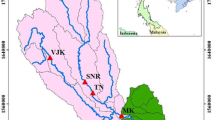Abstract
Unified water flow regulation has been implemented in the Yellow River, Hei River and Tarim River in China since 1999 as a result of institutional reforms. It has been one of the most important water resources management practices in China during recent years and has generated significant impacts. Based on the data of such an experiment in the Yellow River during 1999 to 2004, a “with-without” scenario analysis method is employed in the paper to evaluate the economic and hydrological impacts of regulation through a holistic model coupling economic water use and hydrologic cycle applied to the study basin. The results show that about 2.5% of GDP was increased every year and the Flow Cutoff Events were avoided as a result of the unified water flow regulation.
Similar content being viewed by others
References
Dandy G, Nguyen T, Davies C (1997) Estimating residential water demand in the presence of free allowances. Land Econ 72(2):125–139. doi:10.2307/3147082
Dinar A, Letey J (1996) Modeling economic management and policy issues of water in irrigated agriculture. Praeger, Westport, CT
Faisal IM, Young RA, Warner JW (1994) An integrated economic hydrologic model for groundwater basin management. Colorado Water Resources Research Institute, Fort Collins, CO
Jianshi Z, Zhongjiang W, Wenbin W (2004) Study on the holistic model for water resources system. Sci China Ser E Eng Mater Sci 47(Supp. I):72–89
Lee LK, Moffitt LJ (1993) Defensive technology and welfare analysis of environmental quality change with uncertain consumer health impacts. Am J Agric Econ 75(2):361–366. doi:10.2307/1242920
McKinney CD, Cai X, Rosegrant M, Ringler C, Scott CA (1999) Integrated basin-scale water resources management modeling: review and future directions. SWIM research paper no. 6. International Water Management Institute Colombo, Sri Lanka
Mukherjee N (1996) Water and land in South Africa: economy-wide impacts of reform: a case study for the Olifants river. TMD discussion paper no. 12. Washington, DC: International Food Policy Research Institute
Roe T, Diao X (2000) Water, externality and strategic interdependence: a general equilibrium analysis. J Int Dev 12:149–167. doi:10.1002/(SICI)1099-1328(200003)12:2<149::AID-JID559>3.0.CO;2-K
Whittington D (1998) Administering contingent valuation surveys in developing countries. World Dev 26(1):21–30. doi:10.1016/S0305-750X(97)00125-3
Ximing C (2002) A framework for sustainability analysis in water resources management and application to the Syr Darya Basin. Water Resour Res 38(10):1029
Author information
Authors and Affiliations
Corresponding author
Rights and permissions
About this article
Cite this article
Zhao, J., Wang, Z., Wang, D. et al. Evaluation of Economic and Hydrologic Impacts of Unified Water Flow Regulation in the Yellow River Basin. Water Resour Manage 23, 1387–1401 (2009). https://doi.org/10.1007/s11269-008-9332-y
Received:
Accepted:
Published:
Issue Date:
DOI: https://doi.org/10.1007/s11269-008-9332-y




